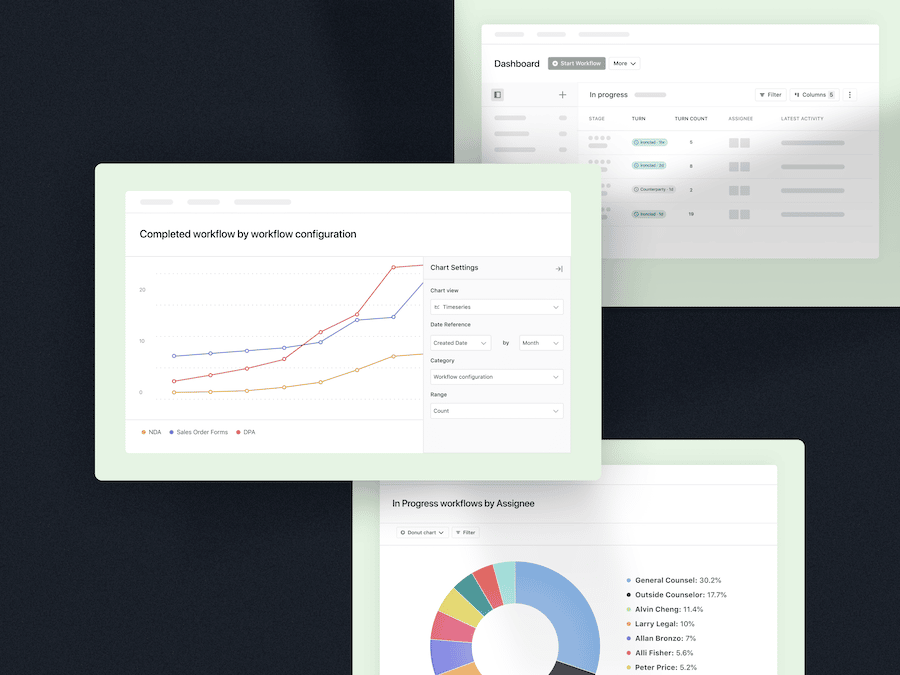If you have a CLM with analytics and reporting functionalities, you can turn existing agreements into ideas to renegotiate vendor contracts, improve workflows, and forecast revenue and expenses. That’s why we’ve built Ironclad Insights.
Insights is a customizable contract analytics tool that lets you look at contract data from new angles to find ways to manage spend. Starting with the hypothetical questions we’ll list in this guide, you can use Insights to learn:
- Which contracts eat up your legal team’s time
- Which vendors to renegotiate terms with
- Where in the sales process contracts tend to get stuck
- How software usage compares to licensing terms
- When to expect revenue and expenses
Legal teams
Questions you can answer:
- How many contracts by type were started last quarter?
- What are the highest-value contract types?
- What is our contract ARR?
- How much time does it take to finalize a contract?
- What are our contract acceptance rates?
- Which departments or individuals have the highest number of days for contract approval?
- How many workflows did each owner execute this quarter?
Legal teams can use contract lifecycle data like agreement type and value to more accurately allocate resources, organize workflows, and communicate potential issues to other departments. For example, if an Ironclad Insights report reveals that NDAs are high-volume and time-consuming, you could implement a click-to-accept workflow to eliminate the need to hire more teammates to manage the workload.
Visualize contract workload by team members to find ways to reallocate resources.
Monitoring contact insights also lets you highlight the legal team’s impact, like quantifying how contact automation reduces the time and cost of processing agreements. Contracting costs have increased, on average, 40% over the last six years—yet the most efficient teams only reported a 9% increase in that time. Imagine finding the contracts and conditions that generate the most pushback, updating templates to be less contentious, and saving hours of back-and-forth negotiations.
Finance teams
Questions you can answer:
- When are upcoming payments due?
- What are the most common payment frequencies for outbound contracts?
- How does company spending vary month-by-month?
- How long does it take to complete each contract type?
Contract data is helpful for forecasting and budget allocation, which helps finance teams manage spending. For example, you can review the average lifecycle length of sales contracts to apply to in-process negotiations to estimate incoming cash flow. Tracking inbound and outbound contract values also reveals trends or spikes that let you know it’s time to ease back on spending or investigate expenditures.
Combining insights about the typical sales contract lifecycle with in-progress workflows lets finance teams forecast incoming payments.
Procurement teams
Questions you can answer:
- How do vendor contract values correlate with software or product adoption?
- What are common vendor agreement clauses?
- What are our upcoming renewals?
- Which vendors have we worked with the longest?
- Is there a contract value threshold that should trigger a no-negotiation threshold versus a bidding process?
Procurement teams can use contract data to review purchasing processes, vendors, and usage to find cost-cutting opportunities. For example, consider not renewing a contract with a high cost and low adoption. Conversely, a vendor with a high contract value but high product adoption is a candidate for negotiating a lower renewal rate in exchange for a longer term.
Use Ironclad Insights to understand how much contract value lies in vendor agreements to investigate whether your investment should go up, down, or stay the same.
Contract data also keeps procurement teams on top of upcoming renewals so you have time to cancel, negotiate, or renew agreements instead of accidentally getting locked into another renewal term.
IT teams
Questions you can answer:
- How does vendor uptime compare to contract value?
- Are there uncommon terms in some contracts that you need to be mindful of or avoid using in the future?
- Are licensing agreement terms underutilized or overutilized?
IT teams can use contract data to compare what you agreed to and what you use. For example, comparing license terms to usage rates reveals underutilized seats you can save money on at renewal time or offer a warning to scale back use if there are over-usage fees. Keeping an eye on upcoming renewals also gives you time to reflect on service downtime or problem resolution issues that you can use during contract negotiation.
Understand how often certain terms appear in your software licensing agreements
Sales teams
Questions you can answer:
- Which contracts had the highest redline rate and turnaround time?
- How many approvers work on a single contract?
- How likely is it that a given sales contract will be approved or rejected by the legal team?
- What stage do deals get stuck in?
- What is the value of terminated contracts?
Sales team contracting has two levers for maximizing business impact—increasing sales and decreasing the customer acquisition cost (CAC). To manage spending in the sales team, review which contracts had the longest turnaround time and look for ways to automate steps of the process. There may even be a threshold where the sales team can use a self-service contract that reduces input from the legal team.
If turnaround time on a particular workflow increases over time, then the sales team might need to investigate the process for costly bottlenecks.
Another opportunity to streamline sales contracting is reviewing how many approvers are involved and how long contracts spend with each party. If contracts slow down internally, consider whether every stakeholder has to be involved. If deals tend to drag on once they leave your hands, consider allowing counterparties to manage their signers so they can reassign authorized signers in case your primary contact is on vacation, for example.
Get creative with contract data
Your organization’s contract data is like a summary of activity across multiple departments, which means you can use Insights to investigate and transform many business processes. We’ve explored more than twenty questions you can use as a starting point to find ways to manage spending, but that’s just the beginning. The more you use and customize your CLM, the greater the quantity and quality of data you can analyze and explore.
Learn more about contract data reporting and, to see Ironclad Insights in action, request a demo today.
Ironclad is not a law firm, and this post does not constitute or contain legal advice. To evaluate the accuracy, sufficiency, or reliability of the ideas and guidance reflected here, or the applicability of these materials to your business, you should consult with a licensed attorney. Use of and access to any of the resources contained within Ironclad’s site do not create an attorney-client relationship between the user and Ironclad.








